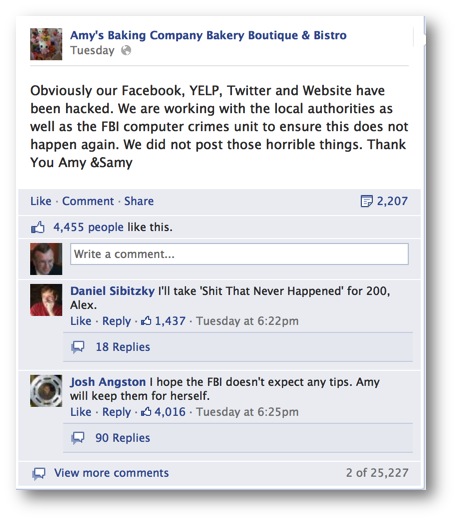Social media is a very powerful tool many brands use today to tell stories and engage with their audience. With this power also comes great responsibility, and brands need to be accountable for the messages they broadcast – be it positive or negative.
We’ve seen brands like Coca-Cola and Oreo absolutely ace at their social media strategy, and then you have a restaurant like Amy’s Baking Company that seem to have fallen miles from grace. While nobody plans for a social media disaster, what’s more important is how to successfully bounce back if and when it happens.
Keep calm and don’t freak out
It’s anyone’s fair game to say whatever they like about you – particularly on social media. Our first instinct will be to get really defensive and we get it, it’s your brand and you have to protect it. But going on a rant on social media is like listening and watching a person scream through a loud-hailer – it’s annoying and embarrassing and can tarnish the brand you’ve worked so hard to build. Be smart, keep calm and breathe!
Check out this classic social media rant from Tinder.
Never claim you were hacked
It’s 2016 and everyone can see through that lie. It’s obvious you’ve just flopped on social media and running away from your mistakes will only anger the public further and escalate the disaster.
Case in point: Amy’s Baking Company
Think before you react
It’s great that your first reaction is to explain what happened. However, it’s important to stop and think carefully about your response as a social media crisis can easily put you in a state of panic.
Structure your official response, be clear and act quickly as a lot can happen on social media in a very short span of time.
Own up to your mistakes
Nobody’s perfect and everyone makes mistakes. Instead of staying silent or claiming that you were hacked, turn it around with a sincere apology. Your fans will appreciate the humility.
Here’s how Expedia apologised and engaged with its customers.
Inject some humour
Trying to turn it around with some humour can work wonders and is a creative way to pick up the pieces. However, it is largely dependant on the severity of the situation and if you’ve hit a nerve on a sensitive issue it’s probably best to handle it with utmost austerity.
Here’s how Burger King handled the negative backlash regarding their fries:
Albeit self-deprecating, the humour was appreciated.
Open up the conversation
In moving forward after the apology, brands can react positively by opening up conversations. In response to a huge social media backlash, Dominos set up a Twitter account to discuss what went wrong. The two-sided communication proved to be a success for them as they were honest and transparent.
A social media disaster is not the end of the world for your brand – what really matters is how you handle it. Some brands bounce back from the backlash because of their ability to repair the damage, while others never do. Always be prepared and have a backup plan.
Need help with your social media strategy? Get in touch with us at [email protected].


